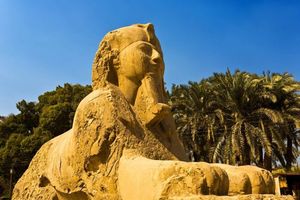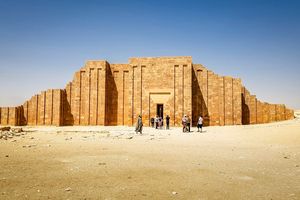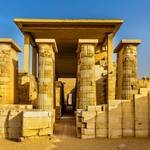Memphis
The oldest structures in Cairo date back only to the last couple of centuries
BC during the Greco-Roman period; however, on the fringes of the city stands the
Giza Pyramids, some of the oldest structures on Earth. Despite their proximity
to Cairo, the difference in age between the pyramids and the city itself is proof of their different histories.
The pyramids at Giza and elsewhere in the desert near Cairo are apart
of the legacy of an older city and civilization that fell into decline long before
Cairo was founded. This civilization named this area Memphis, which was the
seat of power to the Old Kingdom (2686—2181 BC) of Ancient Egypt,
home to the pharaohs that raised the pyramids.
What was the first capital of ancient Egypt?
Memphis was the first capital of Ancient Egypt. Most of the pyramids found near Cairo,
numbering well over 100 in total were built during this period when Memphis
was the most important city in Egypt and most probably the world.
The Ancient City of Memphis, Egypt
History of Memphis City
Manf, Mn nfr, or Memphis is an ancient Egyptian city – one of the World Heritage Sites –
and it was founded in 3200 BC by King Narmer. It was the capital of Egypt in the
era of the Old Kingdom (dynasties 3-6) as well it was the era when god Ptah
(god of craftsman and architects) was worshiped.
Why was it called Memphis?
Memphis was known as the “White Wall,” most probably referring to the palace of the king,
which was built with whitewashed bricks, until the 26th century BC.
The latest name of Memphis is a Greek translation of the Egyptian Men-nefer,
which is the name of a nearby pyramid built in the 6th Dynasty.
The Ancient City of Memphis, Egypt
Where is the City of Memphis?
The ruins of this ancient capital are located 20 km south of Cairo on the west bank
of the Nile River, in a village called “Meet Raheena” in Badrasheen, a city
located 13 miles south of Giza. The site is over 5000 years old so little
of the actual city remains, but it still boasts several impressive artifacts
and an array of statues that have been uncovered in the past century.
The Open Museum in Meet Raheen
Among the most important monuments in the open museum of Meet Raheen –
ruins left from ancient Memphis – are the statue of Ramses II at the entrance
and the huge statue of Ramses II which lies on the ground. There is also a statue
of Alabaster in the image of the Sphinx and some other monuments.
Most impressive by far is the massive statue of Ramesses II that was uncovered there,
measuring over 30 feet tall. Ramesses II ruled from Thebes, near present-day Luxor,
long after the height of Memphis’s power had waned in the 13th century BC,
but this huge statue shows that the city of Memphis remained important
even 1500 years after the Giza Pyramids were completed.
The Ancient City of Memphis, Egypt
Rameses II: Giant Statues and Great History
Located in the remainings of ancient Memphis, a 10-meter length statue
carved from limestone was discovered near the temple of God “Ptah”
(god of craftsmen and architects) by the Italian archeologist Giovanni Caviglia in 1820.
Another giant statue of Ramses II was also found in the temple of God “Ptah”,
which was close to the original shape and it was used to be a central monument
in Ramses Square in Cairo Museum until 2006. This statue is now the most
remarkable icon at the entrance of the Grand Egyptian Museum.
King Ramses II, often regarded as the greatest, most celebrated, and
most powerful pharaoh of the New Kingdom reigned -1279-1213 BC (19th Dynasty),
gained his reputation and the love of the ancient Egyptians due to his many military
expeditions that regained posse to Egyptian lands such as Nubia and Canaan.
His successors and later Egyptians called him the “Great Ancestor.”
The Ancient City of Memphis, Egypt
The Necropolis of the Ancient City of Memphis
Considered one of the most important archeological sites in the world,
the Necropolis of Saqqara was used by ancient citizens of Memphis as a cemetery for
Kings, non-kings, and also animals. The most important tombs found in the
Necropolis of Saqqara was the Mastaba of Ti and the tomb for King Djoser –
found in the Step pyramid of Djoser- the first pyramid ever built.
The Mastaba of Ti – one of the most detailed and preserved tomb ever to be found –
has helped the modern civilization to learn more about life in the Old Kingdom.
It is one of the only resources of knowledge about life in that era.
Saqqara Necropolis is also home to the largest complex of animal cemeteries and cult buildings.
Ancient Egyptians had many pets and animals were very important to agriculture.
Cats were believed to watch over their children while many other animals were
considered sacred such as falcons, hawks, and scarab beetles.
